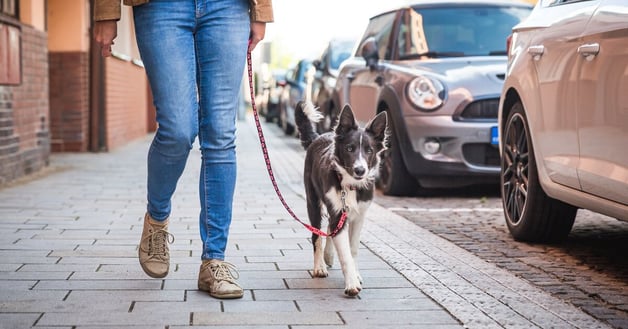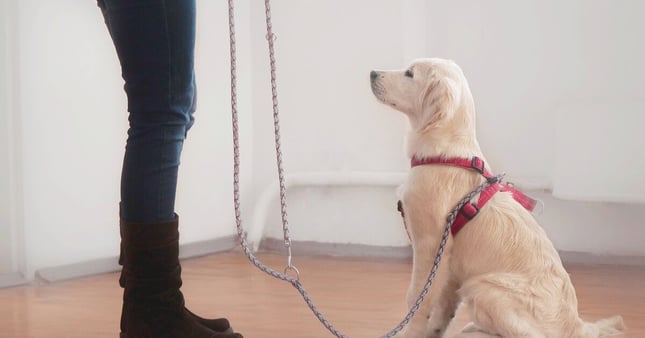How To Train Your Dog To Walk On A Lead
Taking a dog for a walk has everything you need for the perfect activity: plenty of fresh air, exercise, and some great company in your canine companion! But if you’re not prepared, what should be an enjoyable experience can quickly become a tug-of-war.
Does the chaos of a mad dash through the park as your unruly pup pulls away from you sound all too familiar? Well, whether you’re wondering how to stop your dog pulling on their lead or are starting fresh with a new puppy, we’re taking a look at some essential dog training tips. Keep reading to learn more and ensure a calm, enjoyable walk for the both of you!
Why It’s A Good Idea To Start Training Early
First off, it helps to remember that walking is more than just a great source of exercise for your dog. It’s a whole sensory adventure, packed full of mental stimulation from the sights, sounds, and smells your dog encounters.
Of course, while this is great for a dog’s overall wellbeing, so much stimulation at once means it can be quite easy for your dog to become overexcited! From there, a dog constantly pulling on their lead can become tiring or even dangerous in certain situations.

Essentially then, this all leads back to one key dog training tip: the importance of starting training early on in a puppy’s life. While this may not always be possible for all dogs, it’s going to be easier to teach positive habits from the start rather than correcting bad habits later on. This helps dogs become used to this sensory influx early in their development and can assist with future training too.
Training A Dog To Walk On A Lead – The Basics
Before training gets underway, there are a few steps worth mentioning to get the most out of your session with your pup:
- Choose the Right Gear: Consider whether your dog is better wearing a collar or harness as this can differ between pups. Three to four feet is a good length for your training lead but try to avoid retractable or slip leads as these aren’t suitable for training.
- Indoor Training: A top dog training tip that applies to more than just dog walking is to begin indoors. This avoids distractions and will hopefully help to keep your dog’s mind on the task!
- Positive Association: Similarly, remember to reward your dog as you go for remaining close and walking beside you. Treats, toys, and positive attention can all be used as incentives.

Dog Walking Training Techniques
So, how exactly do we go about training a dog not to pull on their lead? There are actually several different ways we can approach training here, so we’re going to take an-depth look at two of the most effective.
Training Method 1: Treats and Cues
The first method for training a dog to stop pulling on their lead involves having your dog by your side while you hold their lead in the opposite hand, so the lead is going across your body. In the hand closest to your dog, you’ll then want to hold your treats. Remember to always use the same hand for giving your dog treats as this will help them to understand which side you want them to walk on and stops them from zigzagging in front of you.
When you’re ready, follow these steps:
- Begin by giving your dog a treat. Once they’ve finished the treat, move away and then lure them back to your side with another treat.
- As your dog begins to understand what’s expected of them, add in a cue word such as ‘let’s go’ or ‘with me’. Say this as you raise your hand with the treats to your shoulder. Move, and if your dog moves forward with you, stop, and reward them with a treat.
- Add in a period of time in which you remain stationary. If your dog begins to pull or move away, lure them back towards you. Remember not to physically pull them back. The idea is to lure them back with treats and positive association so that they move back to your side by themselves.
- Build on your progress by increasing the number of steps you take before giving your dog a further treat.

Training Method 2: Attention and Reward
The second method for training a dog not to pull on their lead follows a slightly different approach. For this one, you’ll want to stand still while your dog is on their lead, letting them have the full length of the lead as necessary. Next, follow these steps:
- Remain quiet and stationary for the whole time your dog isn’t showing you any interest. When they do begin to pay attention to you, give them a reward and lots of praise.
- Next you should move away, using praise and treats to encourage your dog to stay with you. Continue to reward them for walking next to you on a loose lead.
- If your dog moves too far away, stop before the lead gets tight. Then, remain still and quiet once again until your dog returns their attention to you, at which point immediately praise and reward them. Repeat this every time they turn back to you.
That’s all there really is to it! Follow either method and your dog should soon be walking contently by your side.

Extra Dog Training Tips For Walking On A Lead
What’s that? You want a few extra dog training tips to help train your dog to walk on their lead? Oh, alright then, who are we to say no . . . follow these tips to build your bond and make sure your dog gets the most out of your sessions together:
- Practice in short, regular sessions.
- Everyone who walks your dog should use the same methods to ensure consistency.
- Walks can be exciting, even for older dogs! Be patient and remember that walking on a lead isn’t natural for dogs.
- Practice moving around objects at home or in the garden. This is when your dog naturally will think to pull away so they can investigate.
- If you notice your dog is about to lunch at something while on a walk, try to redirect their attention with a treat.
- It helps if your present yourself as fun and exciting as this encourages your dog to remain close. So, show them lots of encouragement and positivity!
- Use cues like ‘watch me’ to train your dog to focus on you amid distractions.
- Once your dog has mastered walking on a lead indoors, move to quieter outdoor areas and gradually increase to more distracting environments.
- It helps for your dog to be in a calm frame of mind during training. Consider using an ADAPTIL Calm Collar to help your dog feel reassured wherever the training is taking place.
- Allow your dog plenty of opportunities to sniff and exploring during walks for mental stimulation.
- If you’re struggling, don’t hesitate to contact a qualified dog trainer for support.
- Avoid jerking back on your dog’s lead or using it to force your dog, as this can cause discomfort and pain.
Remember, a well-trained dog on a lead ensures a safer, more enjoyable walk for both you and your furry companion! Using ADAPTIL Calm can create a more relaxed atmosphere, making the training process more effective. By following these dog training tips and consistently applying these methods, you’ll soon enjoy stress-free walks with your well-behaved canine buddy!
If you’re looking for more advice on how to train your dog or simply want to learn all you can about caring for our furry friends, why not get in touch? You can also stay informed with our latest tips, guides, and product information by signing up to our newsletter.
Related posts
Leave A Comment
Want to sign up for our blog?
Information Notice
The personal information collected is intended for Ceva Santé Animale, and Ceva group companies, in order to manage your request.This information may be passed on to service providers in order to organize this management. In accordance with the Regulations on personal data you have rights of access, rectification and limitation of processing of your data. You may also, in certain limited cases, oppose the treatment, withdraw your consent and request the deletion and portability of your data. For any request relating to your personal data please go to this page